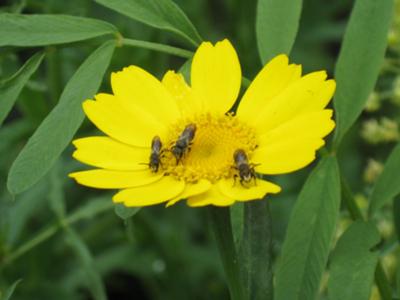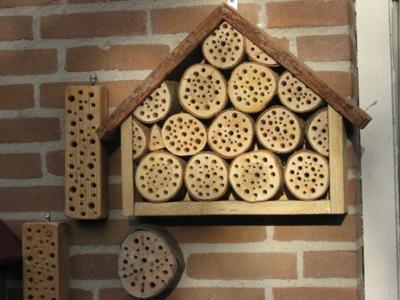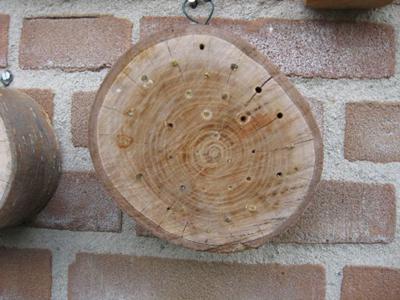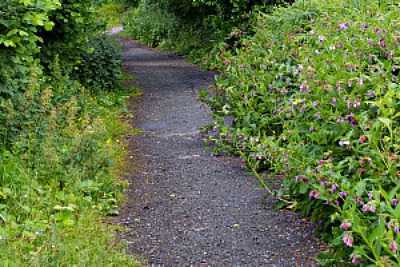Bees In The Garden
Below is an article submitted by a reader in the Netherlands, who is a keen wildlife gardener, and has done much to help bees and wildlife in his garden.
Bees In The Garden - by Marco - (Breda, Netherlands)
When I heard about bee houses, I thought this was nice for those fortunate people with gardens the size of a football pitch.
I think most of us don’t realize how much wildlife can be found in a garden. I decided to buy a few bee houses, and to sow some wildflower seeds.
I
have always loved wildflowers, they seem so very perfect and a small area with
corn marigold and cornflowers is so beautiful. The bee houses I put on a sunny
wall and I nearly forgot about them as I was too busy with the pond and its
life.
All of a sudden, the houses were buzzing with life! There were many solitary bees near the bee house and they loved the wild flowers.
I am no expert but I could identify the Heriades truncorum, a small bee. I was so pleased to see that apparently, my garden was a suitable habitat for them.

Now I started to focus on the bee houses and I could identify more species of solitary bees such as leafcutter bees.
I was glad to see these little holes in the leaves of my sweet briar as it was also clear they were visiting my garden.
 Bee houses on our wall
Bee houses on our wall Bee house made out of cherry wood
Bee house made out of cherry wood
This
year was particularly successful as I found many species of bees. The more you
learn, the more you will enjoy the garden.
Several bumble bee species are found and there was an abundance of red-tailed bumble bees this year, Bombus lapidarius.
On some days more than 20 were found in a part of the garden at the
same time. It all seemed so simple: put several bee houses on a sunny wall,
plant flowers and wait.
Needless to say, not only the bees thrive in the garden: butterflies and moths
do very well as do their respective caterpillars.
These in turn attract many
birds to the garden and I was thrilled to see the long-tailed tits!
Organic
I have always had a great interest in the organic lifestyle.
To me, it seems quite normal that food produced without pesticides is of course better for the environment so whenever I can, I try to buy organic.
One would say: “ok, nice but what has that got to do with bees”? Well, the amount of pesticides used in crops and floriculture is high.
Imidacloprid for example is used in numerous products
such as: apple, pear, tomato, courgette, pepper, potatoes, flower bulbs.
As
imidacloprid may contribute to the severe decline of our honey bee populations,
we should really try to avoid buying products that have been in contact with
imidacloprid.
I therefore buy as much organic food as I can. My purchase will
be a signal to the market (the stores) and the more demand for organic, the
better. Organic should become more main stream.
Sometimes it is not possible to buy organic plants for your garden. Then talk to the supplier and let him/her know about your concern about imidacloprid or the use of other pesticides. This also raises awareness among others.
Non organic does not mean the plant has been treated with pesticides; this depends on the nursery.
Large nurseries with monocultures might be inclined to use more insecticides to
keep pests under control as pests are more likely to occur in monocultures.
Let’s all set the example, and raise awareness and buy as much organic as we
can.
Site owner's comment: Thanks for this great post - you're a man after my own heart! I love those bee houses! You can also make your own bee house with hollow canes. If the canes are blocked at one end, I use a thin skewer to unblock them.
With regard to imidacloprid, it is a widely used neonicotinoid, which is a systemic pesticide. These pesticides work by permeating the whole plant, thus creating a toxic plant for the feeding insect. This means that a sap sucking insect will be poisoned.
Unfortunately, research has shown neonicotinoids also contaminate nectar and pollen. Other neonicotinoid systemic pesticides include Imidacloprid (the most widely used), Acetimacloprid, Clothianidin, Thiacloprid, Thiamethoxam, Dinotefuran and Nitenpyram.
Here is a neonicotinoids snapshot.
A systemic pesticide, Fipronil, works in a similar way to the neonicotinoids.
Unfortunately, some of these chemicals even appear in compost in order to
prevent vine weevils! It seems ridiculous to me that we should risk poisoning
pollinators, just in case we get a vine weevil!
I agree with you about supporting organic. I grow my own veg in pots, and other
than this, I buy as much organic as possible, and that includes plants. Your
purchases send a signal to retailers, who in turn send buying signals to farmers
and growers. Even if we all just buy a few organic items, collectively, it
makes a difference.
Create a
lawn for bees
If you found this page helpful or interesting, I'd really be grateful if you would share it with others - if not this page, perhaps another, such as Gardening For Bees.
Thank you so much :) .
